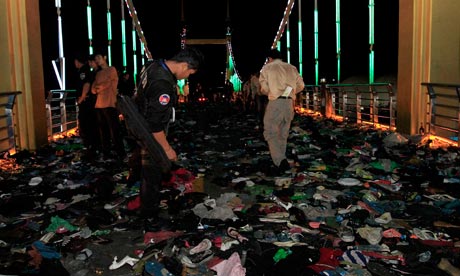At least 340 killed during stampede at festival, and survivors tell of desperate attempt to escape crush

After the dead, the dying and the injured had been removed, the hundreds of abandoned shoes that littered Diamond Island's north bridge still served as a grim reminder of the chaos that had last night turned one of the most joyful events in the Cambodian calendar to tragedy.
The crush is thought to have started at around 10pm, on the third and final day of the festival, which is estimated to attract around a third of the country's 14m population each year to Cambodia's capital, Phnom Penh.
Survivors spoke of being caught up in hellish scenes with people trampling over each in their desperation to escape a crush which Cambodian authorities said had claimed the lives of at least 340 people.
Kim Houng, 29, being treated at Phnom Penh's Calmette Hospital after passing out during the tragedy, said he had only been saved from death by his brother.
"I could only move my body, I could not move my legs. It was hard to breathe," he said. "A lot of people fell down and screamed, 'Help me! Help me!' I also screamed, 'Help me! I cannot help you!'"
After falling down his brother pulled him up. "They stepped on my head, my face, my body," he said. "If not for my brother, I'd be dead. I'm very lucky I'm not dead. Because I thought I'd die."
Prak Kunhea, who suffered a broken leg described people running over her in the panic. "People became scared, they stepped on me, I fell down on the bridge and a lot of people stepped on my body," she said.
Many of the discarded shoes that remained in the aftermath of the tragedy were tiny, testament to the fact that women and children had been well represented among the estimated 4 million revellers, out of a population of just 14 million, that descended on Phnom Penh for the Water festival.
Cambodian state TV said at least 240 of the dead were women, citing reports from two city hospitals. "People were carrying bodies of relatives, including children and women," said Vann Thon, 25. "Everyone was looking scared." Reporters were told last night that the death toll had risen to 341, with 429 injured.
Diamond Island, a small island owned by a local bank and equipped with a newly built conference and exhibition centres, restaurants and entertainment areas, is popular among women shoppers, especially during the Water festival when retailers offer discounts on clothing and other goods.
On television, the fact that prime minister Hun Sen talked about the tragedy in the same breath as the horrors perpetrated by the Khmer Rouge, when more than 1.7m people died, was an indication of what a shock in a country still scarred by the acts of Pol Pot and those around him.
Government ministries were ordered to fly the flag at half-mast. With an underdeveloped health system, hospitals are barely able to cope with daily medical demands, let alone a tragedy of the scale of last night's disaster.
With the light of day will come the inquest into what prompted the panic. "There were too many people on the bridge and then both ends were pushing," Sean Ngu, an Australian who was visiting family and friends in Cambodia, told the BBC. "This caused a sudden panic. The pushing caused those in the middle to fall to the ground, then [get] crushed. Panic started and at least 50 people jumped in the river. People tried to climb on to the bridge, grabbing and pulling [electric] cables which came loose and electrical shock caused more deaths."
In the absence of definitive answers about the cause of the crush, speculation filled the gap. There were rumours of police firing a water cannon onto the bridge, and that people had been trying to get away from a fight that had broken out. The inquest will also likely focus on the bridge – described by Cambodian blogger Longdy as "small" and "toy-like" – and the lights that adorned it, with electrical failure also being mooted. A doctor treating the wounded said suffocation and electric shock were the two main causes of death although the government denied anyone was electrocuted.
Last night the answers to what caused the tragedy were far from the minds of the bereaved. At the Calmette hospital family members camped outside, awaiting news of their loved ones, while inside incense burned around the bodies.
Additional reporting by Phok Dorn of the Cambodia Daily newspaper
|
|
 5:27 PM
5:27 PM
 Phratalkalot
Phratalkalot


















0 comments:
Post a Comment